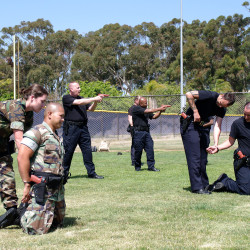Common Correctional Procedures and Terminology
The corrections environment can be a dangerous place, especially for officers who are on the front lines interacting directly with prisoners on a daily basis. Corrections officers are often confronted by potentially violent situations, and it is their job to protect themselves, their fellow officers, and other inmates from harm. In order to do so, it is essential that all correctional officers are highly knowledgeable and trained in the following key concepts:
- Defensive Tactics
- Restraining Devices
- Use of Force
- Cell Extraction
- Inmate Transport
Defensive Tactics
Defensive tactics are typically applied with the bare hands, or light equipment, on persons who pose a physical threat to others. Defensive tactics are frequently required in the correctional environment, when inmates assault other incarcerated persons or prison guards. Although defending oneself is a reflexive action natural to most individuals, training on defensive tactics to improve balance and coordination, along with disabling counterattacks is essential for officers who work in institutional environments. The goal of defensive tactics are to subdue or immobilize an assailant, not to kill or permanently disable the person.
Restraining Devices
Restraining devices or physical restraints are used to subdue, control or contain sentenced offenders who exhibit violent behavior. There are different types of legally permissible restraining devices, and each has a prescribed method of application that does not physiologically compromise the restrained individual at all: Mechanical restraints (handcuffs and leg irons), pinion restraints (restraint chairs and swaddling devices), electronic restraints (taser guns and stun shields), and chemical restraints (tear gas and pepper sprays).
There are also restraining devices that require extreme judiciousness and skill because these could prove lethal if not applied properly: rubber truncheons, K-9 units, and firearms.
REMEMBER: It is unlawful to use restraining devices as instruments for punishing sentenced offenders.
Use of Force
In the corrections environment, there are emergencies that require the use of force: massive and escalating riots in jails and prisons, and violent situations that threaten further loss of life and property are just a few examples.
In these extraordinary circumstances, a corrections officer is justified in the immediate use of force. This means that the officer can exercise discretion on the matter without waiting for CERTs or emergency teams to arrive. In these cases, the corrections officer involved takes full responsibility for the action, and must be fully cognizant of their own rights and responsibilities as well as the rights and responsibilities of the individual they are using force against. Any use of force is typically documented by supervising officers, and reviewed to ensure that proper protocol was followed.
In non-emergency situations, the calibrated use of force is applied. This means that the timing of action and the level of force are planned beforehand. The most common example of calibrated use of force is when officers coordinate a cell extraction for an inmate who has refused to comply with facility procedures. These pre-planned actions are subject to the same guiding principles governing emergency situations, such as using appropriate force and taking measures that do not compromise the health of the inmate (if possible).
Cell Extraction
Cell extraction refers to the forcible removal of stubborn or potentially dangerous inmates from their cells. This is carried out in response to a multitude of potential situations, such as when the subject has injured oneself or a cellmate, or the inmate has refused to submit to urgent procedures (like medical treatment)and needs to be transferred to a safer location.
Undertaken by teams, cell extraction requires the necessary training to ensure that the subject or others (including themselves) are not placed in harm's way. The organization and activation of cell extraction teams are authorized by facility administrators, and must be documented and reviewed thoroughly.
During cell extraction, the use of force and application of restraining devices are necessary. A typical part of the protective gear is the stun shield, which the front element of the team wields as a defensive layer against attack.
Inmate Transport
One of the many assignments a correctional officer may receive is inmate transport, which occurs when an inmate needs to be moved from the facility to another location. The movement usually involves the transported inmate's return to the facility, particularly after court hearings or receiving medical attention from a hospital, but there are cases when the inmate transport is a “one-way ticket” (like permanent removal from the facility, for transfer to another).
In any case, corrections officers on inmate transport take all necessary precautions, and abide by facility guidelines on this procedure, to avoid untoward incidents, such as inmate escape, hostage-taking, and ambush.








